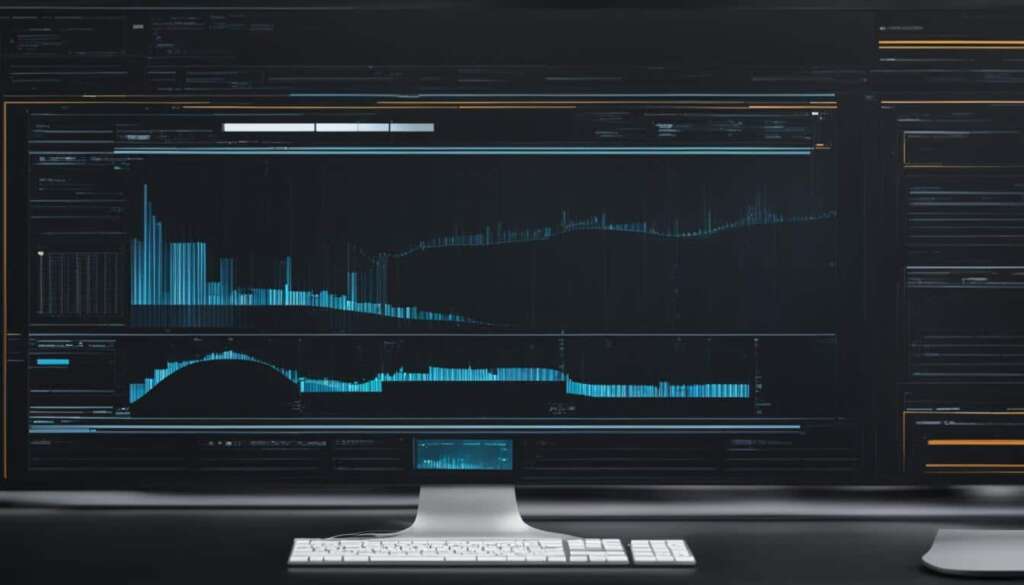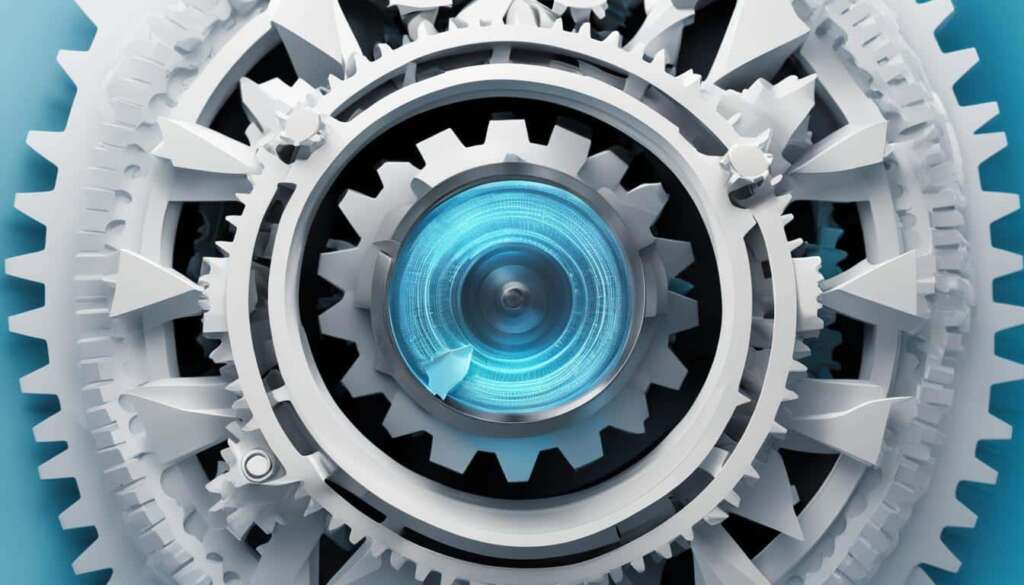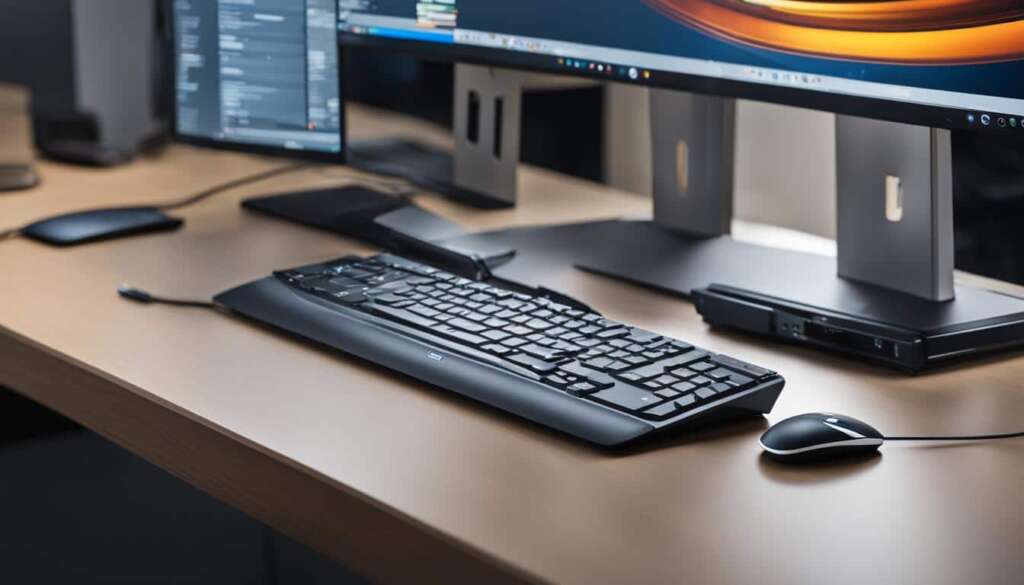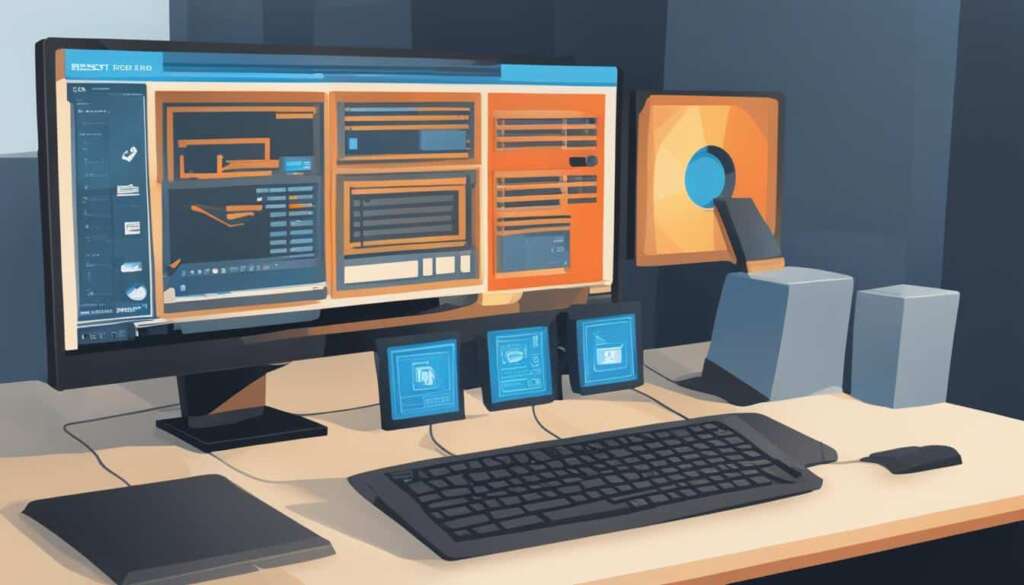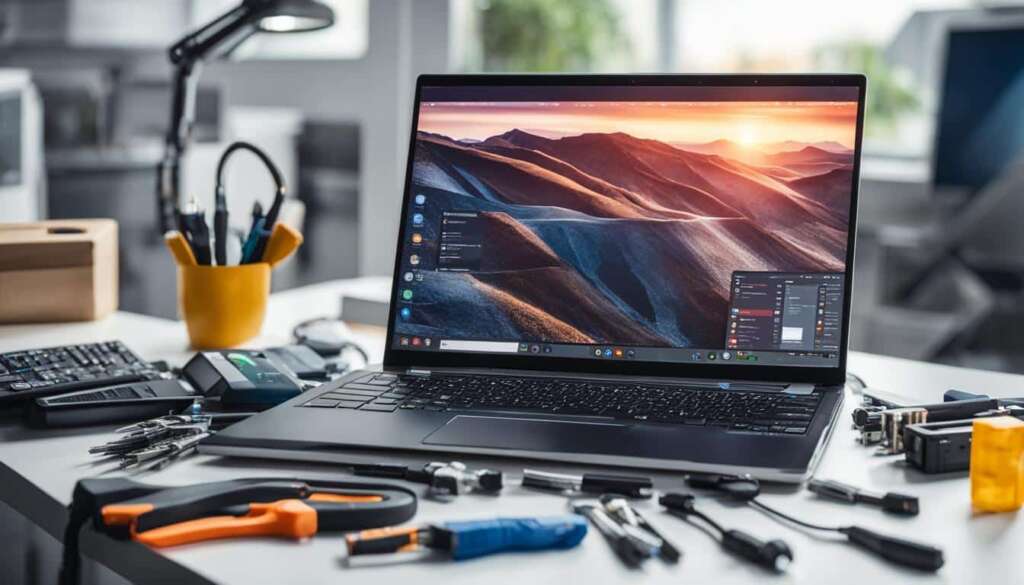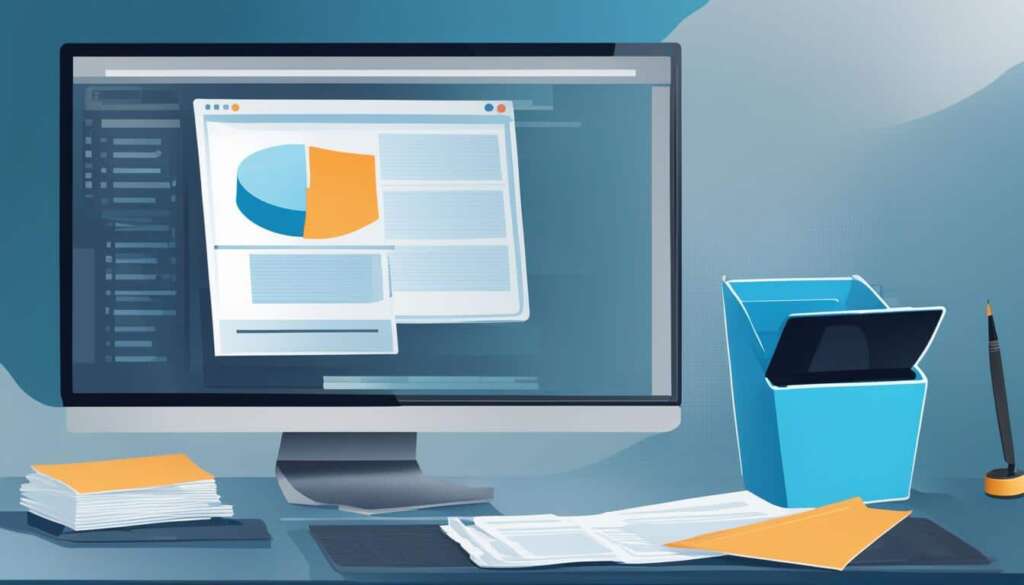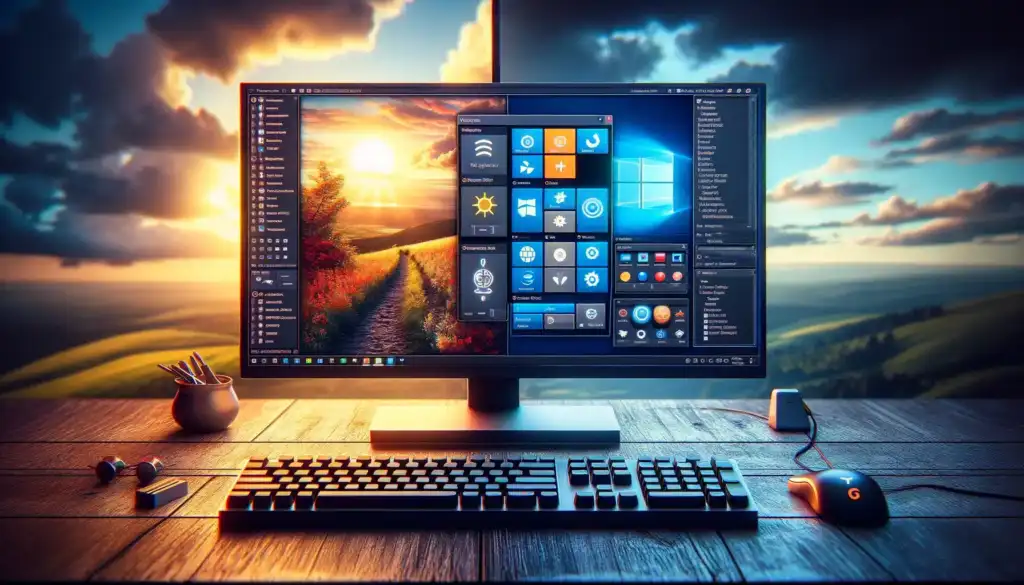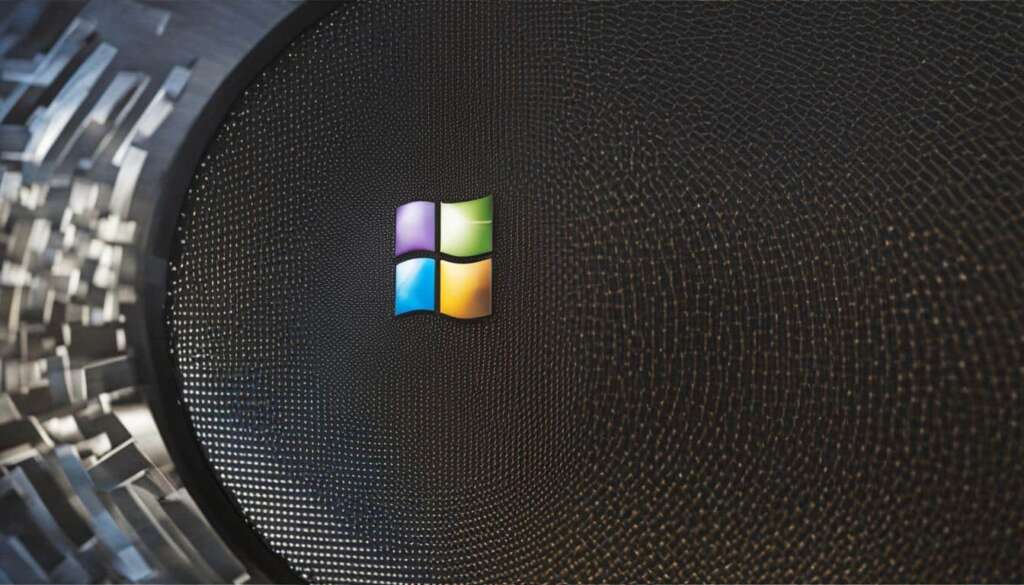Table of Contents
To ensure a smooth experience with your PC, it may be necessary to factory reset it. This process will restore your computer to its original settings, resolving persistent issues or preparing it for sale or donation. In this comprehensive guide, we will walk you through the step-by-step instructions to successfully factory reset your PC, whether you’re using Windows 10 or the latest Windows 11.
Key Takeaways
- Backing up your files is crucial before initiating a factory reset.
- To reset a Windows 10 PC, access the Settings menu, go to Update & Security, and click on Recovery.
- For Windows 11, the reset option can be found in either the System or Windows Updates settings.
- Choose between keeping your files or removing everything during the reset process.
- You can reinstall Windows using local storage or a cloud download.
How to Reset Windows 10
To reset your Windows 10 PC, follow these step-by-step instructions:
- Click the Start menu and select the gear icon to open the Settings window.
- Go to Update & Security > Recovery and click on Get started under Reset this PC.
- Choose whether to keep your files or remove everything.
- Select one of the reinstall options: local storage or cloud download.
- Click Next and review the summary of actions.
- Click Reset to initiate the process.
During the reset process, you’ll be prompted to choose what to erase. You can select “Keep my files” to remove only downloaded apps and settings, while preserving your personal files. If you want to start fresh or plan to sell your PC, you can choose “Remove everything” to wipe the drive clean, including downloaded apps, settings, and personal files.
Before initiating the reset, you’ll need to decide how to reinstall Windows. You can choose “Local reinstall” to install Windows from local storage or “Cloud download” to download files directly from Microsoft’s servers. The cloud download option requires over 4GB of available storage space and provides a faster and reliable alternative to a USB stick installation.
Once all your decisions have been made, click Next to proceed with the reset. Your computer will restart and boot back up after some time. If you chose to keep your files, sign in to Windows and ensure that the selected options have been applied. If you backed up your files, you can now restore them.
| Reset Option | Action |
|---|---|
| Keep my files | Remove downloaded apps and settings, preserve personal files |
| Remove everything | Wipe drive clean, including apps, settings, and personal files |
How to Reset Windows 11
Resetting your Windows 11 PC can be a useful solution for resolving issues or preparing your device for sale or donation. This section will guide you through the step-by-step process of resetting your Windows 11 operating system to its factory settings.
Accessing the Reset Option
To initiate the reset process in Windows 11, you have a couple of options. You can access the reset feature through the Settings menu by navigating to either System > Recovery or Windows Updates > Advanced options > Recovery. Once you’ve reached the Recovery section, click on the “Reset PC” button next to the “Reset this PC” option.
Choose Your Reset Options
After clicking on the “Reset PC” button, a new window will appear, allowing you to choose your reset options. Similar to Windows 10, you will have the choice to keep your files or remove everything. Selecting “Keep my files” will remove apps and settings while preserving your personal files. On the other hand, choosing “Remove everything” will wipe your PC clean, including apps, settings, and personal files.
If you’re unsure which option to choose, it’s recommended to back up your files before proceeding, ensuring you have copies of important data.
Initiating the Reset
Once you have made your selection, Windows 11 will guide you through the final steps to initiate the reset. Review the summary screen to ensure you have chosen the desired options. If everything looks correct, click on the “Reset” button to start the process.
During the reset, your PC will restart and go through the necessary procedures to restore your operating system to its factory settings. It may take some time for the reset to complete, so be patient and avoid interrupting the process.
After the reset is finished, you can sign in to Windows 11 and verify that the selected reset options have been applied. If you backed up your files, you can now restore them to your freshly reset PC.
Summary Table: Reset Options in Windows 11
| Reset Option | Description |
|---|---|
| Keep my files | Removes apps and settings while preserving personal files |
| Remove everything | Wipes clean the PC, including apps, settings, and personal files |
Choosing What to Erase
During the reset process, you’ll have the option to choose what to erase from your PC. This decision depends on your specific needs and preferences. Here are the available options:
Option 1: Keep Files
If you select the “Keep my files” option, your personal files such as documents, photos, and videos will be preserved. However, all downloaded apps and settings will be removed. This option is suitable if you want to start fresh but still want to retain your important files.
Option 2: Remove Everything
On the other hand, if you choose the “Remove everything” option, the reset process will wipe your PC clean. This includes not only downloaded apps and settings but also your personal files. It’s essential to back up any important files before proceeding with this option, as they will be permanently deleted.
By selecting the “Remove everything” option, you can ensure that your PC is completely erased, making it ideal if you plan to sell or donate your device. It provides a clean slate, free from any personal data or lingering files.
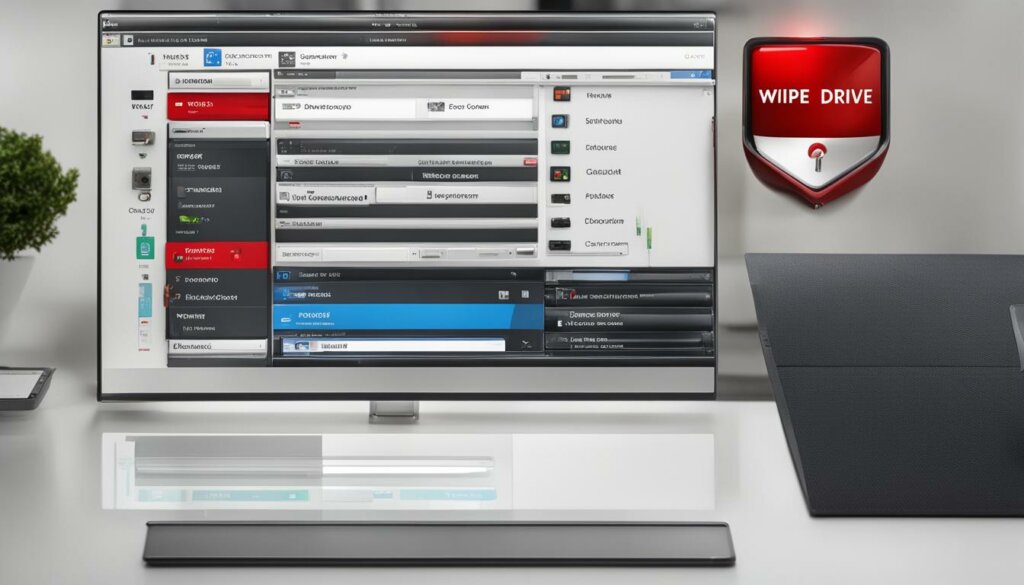
When making your decision, consider your intentions for the reset and the level of privacy or security you require. Choose the option that aligns with your needs and click Next to proceed with the reset process.
| Option | Files | Downloaded Apps & Settings |
|---|---|---|
| Keep Files | Preserved | Removed |
| Remove Everything | Deleted | Deleted |
Reinstall Options
After deciding to factory reset your PC, it’s important to consider how you want to reinstall Windows. There are two options available: local reinstall and cloud download. Choosing the right method depends on your preferences and circumstances.
Local Reinstall
If you prefer to have a physical copy of Windows or have limited internet access, the local reinstall option may be the best choice for you. This method allows you to reinstall Windows from a USB stick or other local storage device. It gives you more control over the installation process and allows you to keep a backup copy of the installation files.
To perform a local reinstall, you’ll need to have a Windows installation media, such as a USB drive with the Windows ISO file. Once you have the media ready, simply follow the on-screen instructions during the reset process and select the local reinstall option. Insert the media when prompted and let Windows complete the reinstallation.
Cloud Download
If you have a reliable and fast internet connection, the cloud download option provides a convenient and efficient way to reinstall Windows. This method allows you to download the necessary files directly from Microsoft’s servers during the reset process. It eliminates the need for physical media and ensures you have the latest version of Windows.
When choosing the cloud download option, make sure you have at least 4GB of available storage space on your PC. This is because the downloaded files will take up some space during the reinstallation. Once you’ve selected the cloud download option, Windows will automatically download and install the necessary files, making the process seamless and hassle-free.
Whether you decide to go with local reinstall or cloud download, both methods will help you restore Windows to its original state and get your PC up and running again. Consider your specific needs and resources to choose the option that suits you best.
| Reinstall Option | Key Features |
|---|---|
| Local Reinstall | Requires Windows installation media (USB stick or other storage device) More control over installation process Allows for offline installation Provides backup copy of installation files |
| Cloud Download | No physical media required Fast and convenient installation Access to latest version of Windows Relies on reliable internet connection Requires at least 4GB of available storage space |
Choosing the right reinstall option is an important step in the factory reset process. Whether you prefer the flexibility of local reinstall or the convenience of cloud download, both methods will help you get your PC back to its original state and ready for use.
Customizing Additional Settings
After selecting the reset options, you have the opportunity to customize additional settings to personalize your PC reset. These settings allow you to tailor the reset process to your specific needs.
Change Settings During PC Reset
During the reset process, you may want to change certain settings to optimize your PC’s performance or customize your experience. By disabling the “Restore preinstalled apps” option, you can prevent the reinstallation of preloaded applications that you may not need, freeing up valuable disk space and streamlining your PC.
Restore Preinstalled Apps
If you choose to keep your files during the reset, the “Restore preinstalled apps” option will be enabled by default. This means that after the reset, your PC will reinstall the applications that were originally bundled with your operating system. By keeping this option enabled, you can easily access and use the apps you were accustomed to before the reset.
Clean Data During PC Reset
If you have decided to remove everything during the reset process, enabling the “Clean data” option ensures that your data is securely wiped from the drive, making it more challenging to recover. This is particularly important if you are planning to sell or donate your PC, as it helps protect your sensitive information from falling into the wrong hands.
Additionally, you can customize the reinstall option during the reset process. You have the choice to reinstall Windows from local storage or opt for a cloud download directly from Microsoft’s servers. The cloud download option offers a faster and more reliable alternative if you have a stable internet connection and sufficient storage space.
Controlling Drive Wiping
In some cases, you may have multiple drives on your PC, and you may want to ensure that all drives are wiped during the reset process. By default, Windows only wipes the drive where the operating system is installed. To wipe additional drives, you can select the option to “Clean the drives, too” during the reset process.
Customizing these settings allows you to have full control over your PC reset, tailoring it to your preferences and specific requirements. By making the necessary changes to the settings, you can ensure that the reset process aligns with your desired outcome.
| Setting | Description |
|---|---|
| Change Settings During PC Reset | Customize the reset process to optimize performance and personalize your experience. |
| Restore Preinstalled Apps | Choose whether to reinstall preloaded applications after the reset is complete. |
| Clean Data During PC Reset | Ensure your data is securely wiped from the drive during the reset process. |
| Reinstall Option | Select between local storage or cloud download for Windows reinstallation. |
| Controlling Drive Wiping | Choose to wipe additional drives during the reset process. |
Resetting Your Computer
Once you have made all the necessary decisions, it is time to reset your computer and return it to its original settings. To do this, click on the “Next” button to proceed with the reset process. Windows will generate a summary screen outlining what will happen during the reset. If you have chosen to keep your files, you can review the list of apps that will be removed. When you are ready, click on the “Reset” button to initiate the process.
Your computer will then restart and begin the reset process. This may take some time, so be patient and allow the computer to complete the reset. Once the reset is finished, your computer will boot back up, and you will be prompted to sign in to Windows. During this step, it is important to ensure that all the selected options have been applied correctly.
If you have backed up your files beforehand, you can now restore them to your computer. Take this opportunity to transfer your files back onto the computer, ensuring that everything is in its place. Once you have completed the restoration of your files, your computer is now successfully reset and ready to be used.
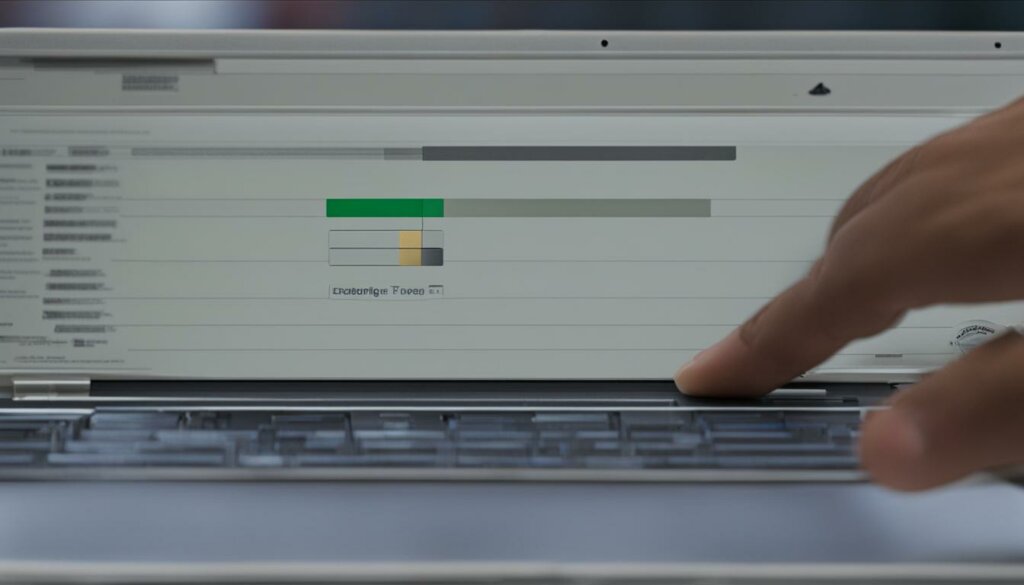
Summary:
- Click “Next” to proceed with the reset process.
- Review the list of apps that will be removed if you chose to keep your files.
- Click “Reset” to initiate the process.
- Allow your computer to restart and complete the reset.
- Sign in to Windows and ensure that the selected options have been applied.
- Restore your backed-up files to your computer.
Table: Finalizing PC Reset
| Step | Action |
|---|---|
| 1 | Click on “Next” to proceed with the reset process. |
| 2 | Review the list of apps that will be removed if you chose to keep your files. |
| 3 | Click on “Reset” to initiate the process. |
| 4 | Allow your computer to restart and complete the reset. |
| 5 | Sign in to Windows and ensure that the selected options have been applied. |
| 6 | Restore your backed-up files to your computer. |
Conclusion
In conclusion, factory resetting your PC can be a useful solution for resolving persistent issues or preparing your device for sale or donation. However, it’s crucial to take the necessary precautions before proceeding. Remember to back up your files as the reset process can potentially erase your data.
By following the step-by-step guide provided in this article, you can successfully factory reset your PC and restore it to its original settings. Whether you’re using Windows 10 or Windows 11, the process is straightforward and customizable to suit your needs.
Before initiating the reset, carefully consider the options available to you. Choose whether to keep your files or remove everything, and decide on the method of reinstalling Windows that works best for you. Additionally, take into account the additional settings you can customize to ensure the reset aligns with your preferences.
In summary, factory resetting your PC can help you start fresh or solve persistent problems. Just remember to back up your files, make informed decisions during the reset process, and follow the step-by-step instructions provided. By doing so, you can successfully reset your PC and restore it to its original state.
FAQ
How do I factory reset my PC?
To factory reset your PC, follow the step-by-step instructions in the guide provided.
Does factory resetting my PC delete my files?
Yes, factory resetting your PC can wipe your data. It is important to back up your files before proceeding.
Can I choose to keep my files when resetting my PC?
Yes, during the reset process, you can select “Keep my files” to remove only downloaded apps and settings, while preserving your personal files.
How can I reinstall Windows after resetting my PC?
You can choose to reinstall Windows using the local storage option or the cloud download option which requires over 4GB of available storage space.
Can I customize additional settings during the PC reset?
Yes, you can customize additional settings such as restoring preinstalled apps or ensuring your data is overwritten and not easily recoverable.
What happens after I initiate the reset?
After initiating the reset, your computer will restart and boot back up. Sign in to Windows to ensure that the selected options have been applied.
Why would I want to factory reset my PC?
Factory resetting your PC can help resolve persistent issues or prepare a device for sale or donation.
How can I restore my files after factory resetting my PC?
If you backed up your files, you can now restore them after completing the factory reset.

